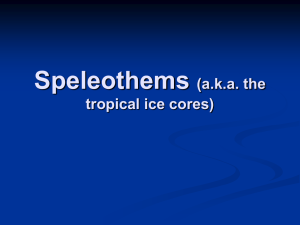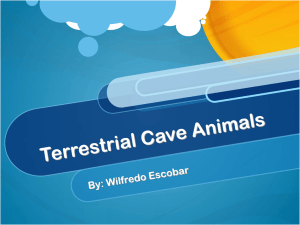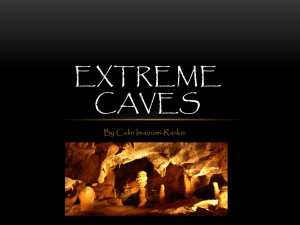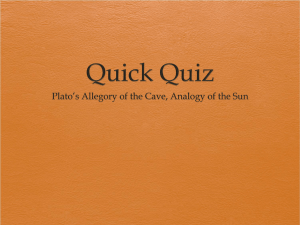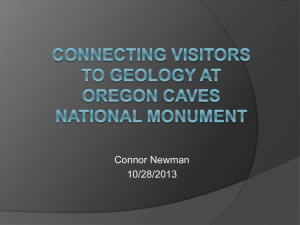calcite speleothems in pseudokarst tjuv
advertisement
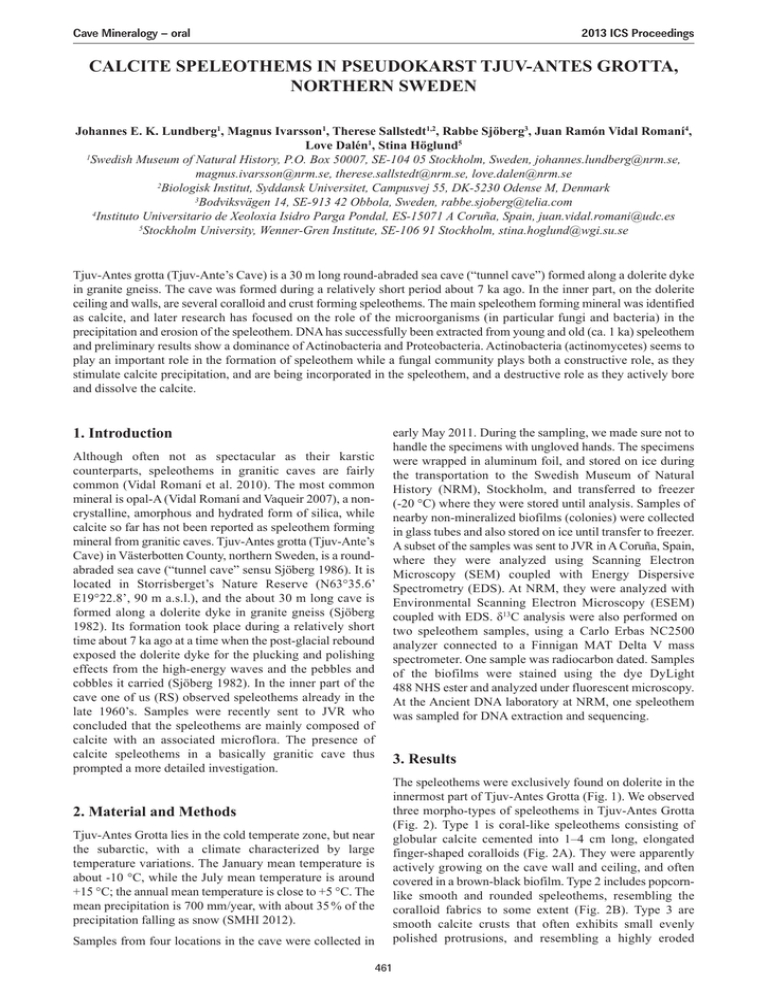
Cave Mineralogy – oral 2013 ICS Proceedings CALCITE SPELEOTHEMS IN PSEUDOKARST TJUV-ANTES GROTTA, NORTHERN SWEDEN Johannes E. K. Lundberg1, Magnus Ivarsson1, Therese Sallstedt1,2, Rabbe Sjöberg3, Juan Ramón Vidal Romaní4, Love Dalén1, Stina Höglund5 1 Swedish Museum of Natural History, P.O. Box 50007, SE-104 05 Stockholm, Sweden, johannes.lundberg@nrm.se, magnus.ivarsson@nrm.se, therese.sallstedt@nrm.se, love.dalen@nrm.se 2 Biologisk Institut, Syddansk Universitet, Campusvej 55, DK-5230 Odense M, Denmark 3 Bodviksvägen 14, SE-913 42 Obbola, Sweden, rabbe.sjoberg@telia.com 4 Instituto Universitario de Xeoloxia Isidro Parga Pondal, ES-15071 A Coruña, Spain, juan.vidal.romani@udc.es 5 Stockholm University, Wenner-Gren Institute, SE-106 91 Stockholm, stina.hoglund@wgi.su.se Tjuv-Antes grotta (Tjuv-Ante’s Cave) is a 30 m long round-abraded sea cave (“tunnel cave”) formed along a dolerite dyke in granite gneiss. The cave was formed during a relatively short period about 7 ka ago. In the inner part, on the dolerite ceiling and walls, are several coralloid and crust forming speleothems. The main speleothem forming mineral was identified as calcite, and later research has focused on the role of the microorganisms (in particular fungi and bacteria) in the precipitation and erosion of the speleothem. DNA has successfully been extracted from young and old (ca. 1 ka) speleothem and preliminary results show a dominance of Actinobacteria and Proteobacteria. Actinobacteria (actinomycetes) seems to play an important role in the formation of speleothem while a fungal community plays both a constructive role, as they stimulate calcite precipitation, and are being incorporated in the speleothem, and a destructive role as they actively bore and dissolve the calcite. 1. Introduction Although often not as spectacular as their karstic counterparts, speleothems in granitic caves are fairly common (Vidal Romaní et al. 2010). The most common mineral is opal-A (Vidal Romaní and Vaqueir 2007), a noncrystalline, amorphous and hydrated form of silica, while calcite so far has not been reported as speleothem forming mineral from granitic caves. Tjuv-Antes grotta (Tjuv-Ante’s Cave) in Västerbotten County, northern Sweden, is a roundabraded sea cave (“tunnel cave” sensu Sjöberg 1986). It is located in Storrisberget’s Nature Reserve (N63°35.6’ E19°22.8’, 90 m a.s.l.), and the about 30 m long cave is formed along a dolerite dyke in granite gneiss (Sjöberg 1982). Its formation took place during a relatively short time about 7 ka ago at a time when the post-glacial rebound exposed the dolerite dyke for the plucking and polishing effects from the high-energy waves and the pebbles and cobbles it carried (Sjöberg 1982). In the inner part of the cave one of us (RS) observed speleothems already in the late 1960’s. Samples were recently sent to JVR who concluded that the speleothems are mainly composed of calcite with an associated microflora. The presence of calcite speleothems in a basically granitic cave thus prompted a more detailed investigation. early May 2011. During the sampling, we made sure not to handle the specimens with ungloved hands. The specimens were wrapped in aluminum foil, and stored on ice during the transportation to the Swedish Museum of Natural History (NRM), Stockholm, and transferred to freezer (-20 °C) where they were stored until analysis. Samples of nearby non-mineralized biofilms (colonies) were collected in glass tubes and also stored on ice until transfer to freezer. A subset of the samples was sent to JVR in A Coruña, Spain, where they were analyzed using Scanning Electron Microscopy (SEM) coupled with Energy Dispersive Spectrometry (EDS). At NRM, they were analyzed with Environmental Scanning Electron Microscopy (ESEM) coupled with EDS. δ13C analysis were also performed on two speleothem samples, using a Carlo Erbas NC2500 analyzer connected to a Finnigan MAT Delta V mass spectrometer. One sample was radiocarbon dated. Samples of the biofilms were stained using the dye DyLight 488 NHS ester and analyzed under fluorescent microscopy. At the Ancient DNA laboratory at NRM, one speleothem was sampled for DNA extraction and sequencing. 3. Results The speleothems were exclusively found on dolerite in the innermost part of Tjuv-Antes Grotta (Fig. 1). We observed three morpho-types of speleothems in Tjuv-Antes Grotta (Fig. 2). Type 1 is coral-like speleothems consisting of globular calcite cemented into 1–4 cm long, elongated finger-shaped coralloids (Fig. 2A). They were apparently actively growing on the cave wall and ceiling, and often covered in a brown-black biofilm. Type 2 includes popcornlike smooth and rounded speleothems, resembling the coralloid fabrics to some extent (Fig. 2B). Type 3 are smooth calcite crusts that often exhibits small evenly polished protrusions, and resembling a highly eroded 2. Material and Methods Tjuv-Antes Grotta lies in the cold temperate zone, but near the subarctic, with a climate characterized by large temperature variations. The January mean temperature is about -10 °C, while the July mean temperature is around +15 °C; the annual mean temperature is close to +5 °C. The mean precipitation is 700 mm/year, with about 35 % of the precipitation falling as snow (SMHI 2012). Samples from four locations in the cave were collected in 461 Cave Mineralogy – oral 2013 ICS Proceedings version of the coralloids (Type 1); this type is often covered in dark biofilms, and is more moist than the other two types (Fig. 2C). A microfabric analysis of vertical profiles reveals that the speleothems have accreted in cycles (Fig. 2D), with alternating dark and lighter layers. These layers can be distinguished in elemental composition; the light layers consist of almost pure calcite, while the silica content is high in the dark layers. There are also elevated levels of Mg and C in the dark layers. The C14-dating gave an age of 1259±30 years B.P. The δ13C measurements of the calcium carbonate range between 9.0 and 11.0‰, suggesting an inorganic source for the carbon. There are mainly two distinct types of biofilms associated with the speleothems: a recent mycelium-like community around the top of the coralloids (Fig. 2E), and a biofilm dominated by small filaments (Fig. 2F) associated with spore-like coccoids (Fig. 2G). The filaments, about 1µm in diameter, are partly incorporated, partly protruding from the matrix, and septated and branching. The mycelium-like filaments are larger, 10–20 µm in diameter, and differ in coloration, and are mostly associated with micro-erosional forms on the speleothem, but also show incrustations with calcite (Fig. 2E). The non-mineralized biofilms were located to fractures in the dolerite on the innermost wall (Fig. 3A). The biofilm is dominated by filaments, only a few µm in thickness and with coccoidal structures, imbedded in a matrix of extracellular polymeric substances (EPS) that also Figure 1. Map of Tjuv-Antes Grotta, Västerbotten, northern Sweden. The location of the speleothems is indicated in dark grey, and the location of the living biofilms in light grey (modified from Sjöberg 1982). Figure 2. Microphotographs by optical microscopy, ESEM images and SEM images. A: Type 1, coral-like speleothems. B: Type 2, popcorn-like speleothems. C: Type 3, smooth calcite crust speleothems. D: Profiles of a speleothem with alternating dark and lighter layers due to cyclic accretion. E: Recent mycelium-like community usually found around the top of the coralloids. F: Biofilm dominated by small, protruding filaments. G: Spore-like coccoids associated with the biofilm. 462 Cave Mineralogy – oral 2013 ICS Proceedings incorporates mineral fragments (Fig. 3B, C). These mineral fragments are dominated by carbonates that appear to be precipitated in the biofilm, but also fragments of the dolerite (composed of Fe, Si, Al, S, Mg, K, Mn, and Ti) are frequent. The fluorescence microscopy revealed that the coccoidal structures are sacs containing smaller, spore-like structures (Fig. 3D). in Tjuv-Antes Grotta thus seem to consist of heterotrophs, probably living of organic matter transported from the surface by percolating fluids and/or on the bacterial communities. It is not known if there are any chemoautotrophs in the dolerite that can act as a carbon source for the heterotrophic communities on the cave walls. The DNA is still under analysis, but preliminary results show that large amounts of DNA were extracted, and that they represent several distinct phylogenetic lineages. 4.2. Mineralogy Both the speleothem and the active biofilms are concentrated to the dolerite; no speleothems are found on Figure 3. A: Photograph of the modern, non-mineralized biofilms located to fractures in the dolerite on the innermost wall. B, C: ESEM images of the biofilm with filaments and coccoidal structures imbedded in a matrix of extracellular polymeric substances (EPS) that also incorporates mineral fragments. D: Samples of the biofilms stained using the dye DyLight 488 NHS ester and analyzed under fluorescent microscopy, which revealed that the coccoidal structures are sacs containing smaller, spore-like structures. 4. Discussion the granite. This makes Tjuv-Antes Grotta most related to volcanic (basalt) caves with respect to secondary mineralizations. The calcium content is high in dolerite compared to granite, due to the presence of anorthite, a calcium-rich plagioclase. This readily explains the presence of calcite speleothems in many volcanic caves (White 2012), and also in Tjuv-Antes Grotta. The mechanism of calcite speleothem formation in volcanic caves is the same as in limestone caves, where meteoric water supersaturated with calcium precipitates calcite in the cave environment. The difference between limestone caves and caves in mafic rocks (e.g., volcanic caves and dolerite caves) is the source of calcium. In the mafic rocks calcium is likely to be derived from the breakdown of anorthite and not from calcium carbonates as in limestone. Even if anorthite is the least stable of the common mafic minerals, its breakdown is normally much slower than the dissolution of limestone, explaining the less developed speleothems in mafic caves, together with the much younger age of many volcanic caves. 4.1. Biofilms From the morphology, the thinner filaments found both in the non-mineralized wall biofilms and on the growing speleothems, can be attributed to the bacterial order Actinomycetales (Miyadoh et al. 1997). This is a diverse and large group of bacteria with a global distribution in particular in soils but also from various types of caves including karst, lava tunnels and granitic caves (Groth et al. 1999; Jones 2009; Northup et al. 2011; Porca et al. 2012). It is however likely that the biofilms do not consist of actinomycetes exclusively but of various bacterial communities, which will be characterized in future molecular studies, even if the actinmycetes appear to be the dominating group of bacteria in Tjuv-Antes Grotta. The dominance of actinomycetes in the cave is expected: both the low temperature and the relatively high humidity are factors that promote growth of actinomycetes in caves (Groth and Saiz-Jimenez 1999). The thicker filaments are consistent with fungal hyphae. The microbial populations 463 Cave Mineralogy – oral 2013 ICS Proceedings 4.3. Life cycle of the speleothems References The speleothems in Tjuv-Antes Grotta seem to be highly influenced by the microbial presence. The actinomycetedominated biofilms cover most of the surface of the growing speleothems, and seem to be incorporated in the darker layers of the speleothems. There are also apparently abiotic growths of the speleothems (as deduced from the δ13C analysis), resulting in the light colored bands. It is still possible that microbial activity have indirect influences also on this phase of the growth by altering the microenvironment to facilitate precipitation of calcite (Castanier et al. 1999). Castanier S, Le Metayer-Levrel G, Perthuisot J-P, 1999. Cacarbonates precipitation and limestone genesis: the microbiogeologists point of view. Sedimentary Geology, 126, 9–23. Groth I, Siaz-Jimenez C, 1999. Actinomycetes in hypogean environments. Geomicrobiology Journal, 16, 1–8. Groth I, Vettermann R, Schuetze B, Schumann P, Saiz-Jimenez C, 1999. Actinomycetes in karstic caves of northern Spain (Altamira and Tito Bustillo). Journal of Microbiological Methods, 36, 115–122. Jones B, 2009. Phosphatic precipitates associated with actinomycetes in speleothems from Grand Cayman, British West Indies. Sedimentary Geology, 219, 302–317. The fungal presence seems to have a dual role in the life cycle of the speleothems. There are evidence for a constructional role by precipitation of calcite (encrusted hyphae), but also for an erosion dominated phase, that may be responsible, at least in part, for the Type 3 speleothems. Miyadoh S, Tsuchizaki N, Ishikawa J, Hotta K, 1997. Digital Atlas of Actinomycetes. Society for Actinomycetes Japan and Akasura publishing, Tokyo. We are still awaiting the results from the molecular analysis of the microbial communities in the speleothems. We would also like to characterize the different phases in the speleothem life cycle, and the different contributions from the microbial communities. Northup DE, Melim LA, Spilde MN, Hathaway JJM, Garcia MG, Moya M, Stone FD, Boston PJ, Dapkevicius MLNE, Riquelme C, 2011. Lava cave microbial communities within mats and secondary mineral deposits: implications for life detection on other plantes. Astrobiology, 11, 601–618. Acknowledgment Porca E, Jurado V, Žgur-Bertok D, Saiz-Jimenez C, Pašic L, 2012. Comparative analysis of yellow microbial communities growing on the walls of geographically distinct caves indicates a common core of microorganisms involved in their formation. FEMS Microbiology Ecology, 81, 255–266. The speleothems were collected in a Nature Reserve and Natura 2000 Site, with permission from the County Government Länsstyrelsen Västerbotten (permission 5216864-2010), and we want to thank the Länsstyrelsen for the permission. Some of the analyses (ESEM/EDS, fluorescent microscopy and stable isotope analysis) were conducted at Stockholm University; in particular we would like to thank Marianne Ahlbom at the Department of Geological Sciences for assistance during the ESEM. Many thanks also to Dr. Bogdan P. Onac (University of South Florida) and one anonymous reviewer for valuable comments on an earlier draft of the manuscript. Sjöberg R, 1982. Tunnelgrottor i södra Västerbotten: morfologiska och morfogenetiska studier. Gerum Rapport, A31. Sjöberg R, 1986. Tunnelgrottor i Norden: geomorfologiska studier. Gerum Naturgeografi 3. Umeå University, Umeå. SMHI 2012. Klimatdata, http://www.smhi.se/klimatdata (visited 2012-12-13). White WB, 2012. Secondary mineral in volcanic caves: data from Hawai’i. Journal of Cave and Karst Studies, 72, 75–85. Vidal Romaní JR, Vaqueiro M, 2007. Types of granite caves and associated speleothems: genesis and evolution. Nature Constervation, 63, 41–46. Vidal Romaní JR, Sanjurjo Sánchez J, Vaqueiro M, Fernández Mosquera D, 2010. Speleothems of granite caves. Communicações Geológicas, 97, 71–80. 464
